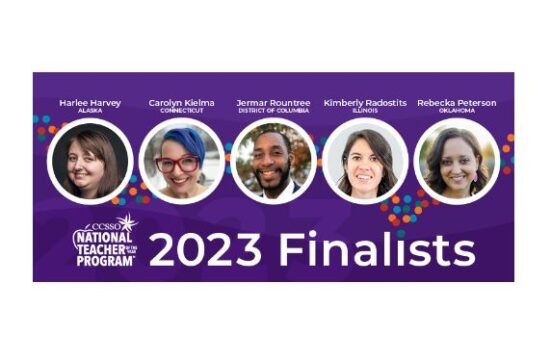The Council of Chief State School Officers has selected five finalists for National Teacher of the Year from a cohort of 55 educators. The winner will be announced in the coming weeks.
High-school Spanish teacher Kimberly Radostits is the 2023 Illinois Teacher of the Year. SmartBrief interviewed her about helping students feel valued, treating them with equity and the challenges that teachers are facing.
This Q&A has been lightly edited for clarity and space.

Kimberly Radostits says she firmly believes she would not be where she is today without the experience of becoming and teaching as a National Board Certified Teacher. Where this high-school Spanish teacher is is this year’s Illinois Teacher of the Year and a finalist for National Teacher of the Year.
Radostits, who became an NBCT (world languages) in 2011 and renewed in 2020, mentions reflection and relationships as important parts of being an NBCT. She says she sees herself as “unfinished as an educator” and notes that reflection helps her be the best version of herself.
Among the ways the certification process has informed her work, Radostits says, is building relationships — getting to know all of her students, their strengths, weaknesses and interests to inform her lesson plans with goals in mind. She also goes beyond her own classroom and into a mentorship program for freshmen who are at risk of not graduating on time. In addition, her school’s New Teacher Academy brings novice teachers and experienced peers together for dinners that also include an hour of timely and calendar-linked professional development, such as discussions about mental health during December when teachers can feel burned out, she says.
Additional ways include being intentional in partnering with families to ensure they are connected to the school, she says.
“A lot of that came out of reflection that I’ve had through the National Board certification process that early on in my career those were the things that were working,” Radostits said in this interview with SmartBrief. “Those connections and that collaboration. So for many different reasons, this really has put me in the position I’m in today.”
Ms. Rad, as she is known to students, says she always loved school and knew from an early age that she would be a teacher when she grew up, so her educators encouraged her by providing various opportunities to mentor younger peers.
Spending most summers in Mexico, where her mother is from, sparked her “passion for the culture of the Spanish-speaking world,” so she decided to share that love by teaching the language to students.
It was a challenge to renew her National Board certification during school closures in 2020, but Radostits says there were benefits. The process pushed her out of her comfort zone to do what she does in the classroom — build connections and collaborate — while teaching remotely. One effort included a weekly system for students to earn points by offering more learning, such as additional meeting opportunities and games nights.
“I don’t know that I would have thought of that had I not been in that mindset of that whole NBCT renewal process,” she says.
SmartBrief: A lot is asked of teachers in the US, often without getting a lot in return (whether pay, recognition or support). What can school districts and/or principals do to help teachers who are tapped out, retain educators and recruit new ones when the job can sometimes seem so overwhelming?
Radostits: My philosophy is that every student deserves to feel known and valued, and should be given equitable access to the skills and the support that they need to be successful. Teachers need all the same things. There are three things that I believe would make a huge difference in retaining teachers and recruiting new ones:
- The greatest resource we have as humans is time, and, outside of instructional minutes, time in school is best spent collaborating with peers. To come out of this pandemic stronger than when we went in, we need to come together as a community. Teachers need time to collaborate with their peers and to talk about the students they engage with on a daily basis and the strategies that are impacting the data we are asked to collect. To meet the needs of the whole child, teachers need time to engage with other stakeholders, including parents, school psychologists and other specialists.
- Within the last decade, a lot of districts have invested resources into mentorship and professional development for first-year teachers, which has certainly had a positive impact. That said, support and professional development opportunities shouldn’t end after year one. To retain teachers, we need to make sure that we sustain systems of support in years two and beyond so teachers can be the lifelong learners that we ask our students to be.
- We have amazing teachers in this country who are giving the best version of themselves to students everyday. That needs to be celebrated, not necessarily in the form of donuts and jean passes, but in genuine thank-yous and specific praise. That work requires leaders to be in classrooms, the halls and extracurriculars to see the magic that is happening everyday. Let’s empower educators by helping them see the strengths they possess so they can share more of that gift.
SmartBrief: We hear so much about teachers who want to make all students feel valued and gifted and capable of great things, and the importance of connecting with them — learning about a student’s home life, going to their sports or extracurricular activities. Do you have tips for ways to do this that won’t encroach into a teacher’s personal time or have some out-of-the-ordinary ways to connect?
Radostits: Making students feel valued doesn’t always have to happen with grand gestures. An easy way to make students feel valued is to give them a space where they feel heard and appreciated. To do this, time needs to be built in for students to engage in meaningful dialogue in the classroom. This can happen by giving students partner or group work, where the teacher walks around the room and checks in with individuals and small groups to make short but frequent connections. In this format, content in classes can be used as a vehicle to connect with students, and there are teachers doing that work everyday.
For those students who prefer a more private interaction, sticky notes are my best friend. I use them daily for quiet, personal check-ins, celebrations and reminders. These small acts help students feel seen and ensure they aren’t flying under the radar.
SmartBrief: Behavior problems seem to have increased among students since the beginning of the pandemic, but this issue has always existed. What are your classroom management strategies for dealing with disruptive behavior and regaining control of the room? Is it different now than in the past?
Radostits: The change in behavior issues likely varies across the country, but, what I can definitively say about the students in our schools is that they have experienced a collective trauma as a result of the pandemic.I am mindful of creating a classroom environment where students feel safe and know the expectation of being respectful to others, themselves and our space.
I make sure to reinforce positive behaviors consistently, and I post the “objective of the day” so students know the target, as well as post a bulleted agenda of what they will experience during the period to relieve any anxiety they may have about where we are headed.
When planning, I try to set up lessons where there is whole group discussion in which I can guide the learning, followed by small group activities where students can interact with others and move around, followed by independent work to work quietly with a peer. This format allows me to meet the needs of all learners where they get variety during the lesson and also allows me to move around the room and talk to individuals about their progress.
With this setup, I am able to deter most disruptive behaviors. For behaviors that are pervasive, I make sure to collaborate with the colleagues who share that student, the parents of the student and any other school professionals who might be a valuable partner in making sure that student is successful in the future.
SmartBrief: Collaboration with peers and administrators seems like a thread that ties together all the National Teacher of the Year finalists. What does successful collaboration look like? What are your favorite collaboration tools to engage and learn with other teachers, whether in your school or district or beyond?
Radostits: When speaking to teacher candidates, I often tell them that when joining the profession you will never be alone. The pandemic proved that. When we were all tasked with doing the unimaginable in education. The boundaries of professional development faded as teachers across the globe were seen sharing resources, working collaboratively and coaching each other.
That shouldn’t stop now. We have seen that when we come together and share our skill sets, we can make amazing things happen for students. That said, social media really did become a great place for teachers to do some of that work. As a Spanish teacher, there is a Facebook group called “Spanish Teachers in the US” that I am able to turn to for support. There are many other platforms that can be used in this way to learn from other teachers outside of your building and to grow your professional learning network.
Collaboration within school communities is important too. I am sure there are many factors to making sure it is successful, but it starts by being intentional about setting aside time for meaningful conversations.
In my time as Illinois Teacher of the Year, I have been interviewing schools that are high performing with freshmen-on-track rates. Almost every school I have met with says what works are weekly or biweekly meetings in which teachers, administrators and other school professionals come together to discuss student performance. During these meetings, data from school information systems are being utilized to identify needs, but so are anecdotes from teachers who work with the students. These conversations allow these adults to meet the needs of the whole child.
In my own school, I have witnessed the power of these partnerships as these conversations often extend outside the scheduled meetings into conversations next to the copy machine, the water fountain and in the school parking lot, because strong relationships amongst colleagues have been formed.
Trigie Ealey is an editor for SmartBrief Education.
Opinions expressed by SmartBrief contributors are their own.
_________________________
Subscribe to SmartBrief’s FREE email ASCD newsletter to see the latest hot topics in education. It’s among SmartBrief’s more than 250 industry-focused newsletters.
